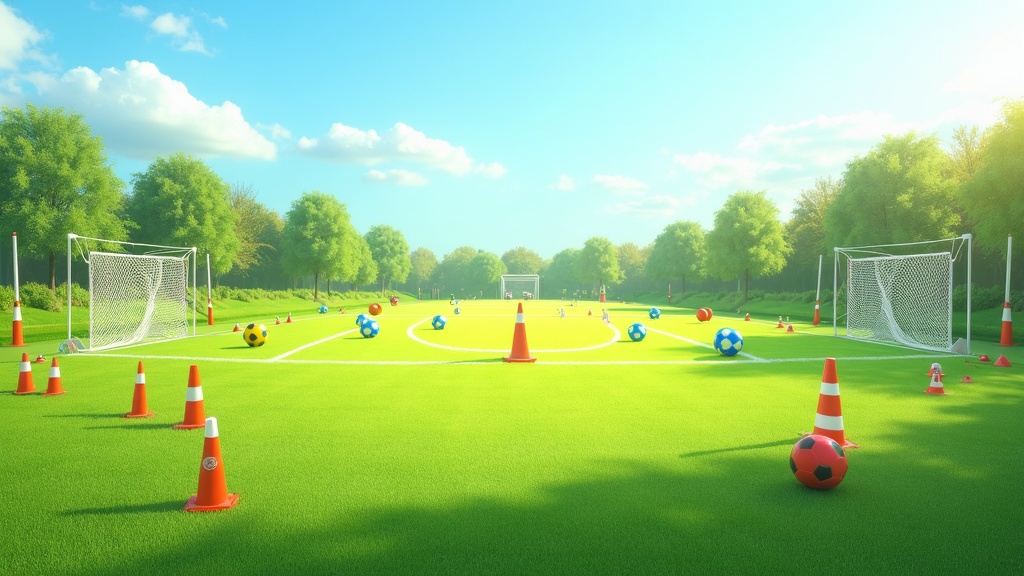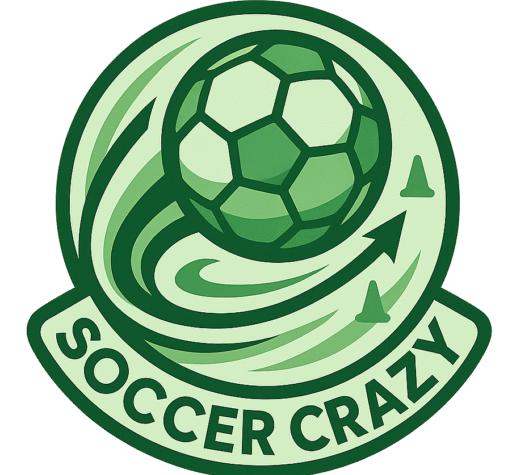Getting kids involved in soccer is one of the best ways I’ve seen to build their confidence, keep them active, and teach valuable life skills.
The drills you pick, and the way you run them, matter a lot, whether you’re a coach, a parent, or just someone helping out at practice.
This guide is packed with everything you need for youth soccer drills: from activities for total beginners to advanced tips, plus links to more detailed posts for each specific type of drill.
My hope is you’ll find ideas here that help your young players develop solid fundamentals and have a blast doing it.

Why Youth Soccer Drills Are So Important
Kicking the ball around with friends is fun, but good drills take player development up a notch.
Drills give kids a chance to practice skills in a focused way, which helps the basics sink in a lot quicker.
Repeating movements, like passing, dribbling, or shooting, builds the muscle memory that leads to real confidence on game day.
Running the right drills also teaches discipline, teamwork, and even how to work through frustration.
And when you make sessions upbeat and positive, there’s a much better chance kids will stick with soccer long-term and really enjoy the process.
Over time, structured practice leads to better coordination, sharper tactics, and stronger bonds on and off the field.
I’ve noticed that players who do regular skills training just seem to have an easier time reading the game and working effectively as part of a team.
Core Principles for Effective Youth Soccer Drills
Not every drill is a great fit for every age or situation, so a little bit of planning goes a long way. Here’s what helps me choose and run the best drills for youth teams:
- Age Appropriate Training: Younger kids (think under 8 or under 10) need simple instructions and easy skills, while older players can be pushed a bit more with tactical challenges and faster paced activities.
- Keeping It Fun: Turning drills into games, like “Sharks and Minnows” or “Red Light, Green Light” for dribbling, makes practice something everyone actually looks forward to.
- Repetition With Variety: Practicing the same core skill in a few different ways means kids never get bored but still lock in important habits. For example, passing drills can change target size, distance, or add defenders.
- Small Sided Format: More touches per player equals more learning. Reducing group size, even just 2 on 2 or 3 on 3, makes every kid more involved, which builds skill and confidence quicker.
- Positive Reinforcement: Simple encouragement, cheers for effort, and celebrating small wins goes a long way. This isn’t just about learning, it’s about building up kids who love the game.
Even seasoned coaches sometimes underestimate the power of a simple setup.
Laying out cones or using fun names for drills makes young players more excited to participate.
Including brief one-on-one talks in every practice, such as asking a player what was most fun or what was tough today, also deepens their enjoyment and growth.
If you incorporate laughter and encouragement, you’ll see their eagerness to try new challenges skyrocket.
Types of Youth Soccer Drills (Links to Drill Categories)
If you’re not sure where to start with drills or want something new to try out, there’s a whole universe of options. Here’s how I like to break them down, with links to separate guides for each drill category:
- Beginner Drills for Kids – The basics: dribbling, simple passing, and first touches.
- Age Specific Drills – Activities designed specifically for younger (U7) players.
- Passing Drills – For building accuracy, timing, and communication.
- Dribbling Drills – Control, quick feet, and confidence with the ball.
- Shooting & Finishing Drills – Technique, power, and scoring composure.
- Small Sided Game Drills – For improving teamwork and tactical awareness.
- Fitness & Agility Drills – Fun conditioning to keep players sharp without burning them out.
- Defensive Drills – How to cover, intercept, and win the ball back.
- Goalkeeper Drills – For the brave kids who love being in goal.
- Indoor Drills – Easy training options when the weather isn’t cooperating.
Each of these linked guides digs deeper into practical activities, coaching tips, and full instructions you can use right away.
When you check out these guides, you’ll stumble upon age tips, tactics for smooth practice sessions, plus detailed breakdowns for turning each drill into a favorite activity.
How I Structure a Youth Soccer Practice Session
There’s a rhythm to a good training session, and getting it right helps keep energy up and kids on track. Here’s the flow I’ve found works for most youth teams, especially somewhere in the 8 to 12 year old range:
- Warm Up (10 minutes): Fun, simple games with dynamic stretching. Think tag, “Simon Says,” or passing relays to get hearts pumping and muscles loose.
- Skill Drills (25 minutes): Focus on one or two skills (maybe dribbling and simple passing), with progressions for kids who pick it up fast. I change the drills up every session or two.
- Small Sided Game (20 minutes): Play 3v3 or 4v4 mini games on a shrunken field. This is where kids practice their new skills and get to compete in a low pressure way.
- Cool Down & Reflection (5 minutes): Walk and talk cooldown, easy stretching, then a quick chat about what went well or what we’ll try next time.
Sample U10 Session Plan (1 Hour):
- 10 min: Dribble tag plus stretching
- 10 min: Passing with cones target
- 15 min: “Sharks and Minnows” dribbling game
- 20 min: 4v4 small sided match
- 5 min: Stretch and “wins of the day” reflection
I also recommend including some variety by switching up which skills you focus on week to week.
For instance, one session might emphasize shooting and defending, while another might be about passing and creative movement.
Occasionally incorporating a quick quiz or discussion about the rules or positions can boost understanding and get kids invested mentally as well as physically.
If your group loves competition, ending with a fun challenge (like who can juggle the ball most times or who can dribble through a course fastest) is always a winner.
Common Mistakes Coaches and Parents Make
Even the most well meaning adults can miss the mark with youth soccer drills. I’ve learned to avoid a few classic pitfalls:
- Complicated Instructions: If it takes longer to explain than to play, it’s too complicated. Simple is always better for kids.
- Ignoring Skill or Age Differences: A drill that’s fun for 11 year old’s might be too tricky for 7 year old’s. Adjust activities to fit who’s there.
- Obsessing Over Winning: The focus during drills should be on learning, not nonstop scoring or perfect performance.
- Repeating the Same Drill Every Time: Kids check out if it’s the same old routine each week. Rotating drills fuels excitement and growth.
- Forgetting Fun: If the kids look bored or frustrated, it might be time to change things up or lighten the mood. Smiles mean learning is happening.
Another common mistake is forgetting to include everyone.
Make sure all kids take part equally — no one should be left on the sidelines for too long. Mixing up team pairings also helps everyone build new friendships.
If you ever notice kids comparing themselves too much to others, remind them that everyone improves at their own pace and that their hard work stands out the most.
Handy Equipment for Youth Soccer Drills
Investing in a small kit of basic gear makes training sessions run more smoothly. Here’s what I pack for most practices:
- Cones and Markers: For setting up dribbling courses, marking fields, and keeping things organized.
- Agility Ladders: Awesome for fun speed drills (and not just for soccer either).
- Portable Popup Goals: Super useful for scrimmages at the park or on the go.
- Rebound Nets: These make solo passing and shooting drills a lot more interesting.
- Training Balls: Slightly smaller and lighter ones are great for young hands and feet.
If you’re looking for reliable gear to start, my favorite picks are here. These options are durable, budget friendly, and easy to carry for parent coaches.
You might also want to add pennies (scrimmage vests) to help distinguish teams, a whistle for attention, and a stopwatch or phone timer to keep things on schedule.
Having a water break station nearby encourages healthy habits and keeps energy up all session long.
FAQs: Your Youth Soccer Drills Questions Answered
Here are some of the most common things I get asked by new coaches and parents:
Q: How long should a single youth soccer drill last?
Most drills click in the 5 to 15 minute range. Once focus drops or progress stalls, move to something new.
Q: How many drills should I do per session?
Three to four well run drills are plenty for most ages. Too many activities tend to confuse or overwhelm younger kids.
Q: What’s the easiest drill for total beginners?
Simple “dribble through the cones” or “red light, green light” is always a win. Focus on lots of touches and making it playful.
Q: Can we practice drills at home without a full soccer field?
Absolutely. Many core drills work in a backyard, gym, or even indoors. Just use cones, markers, or whatever is around to set up stations.
Q: What’s a good way to keep kids motivated?
Mix up the activities, cheer on effort, and always celebrate both teamwork and improvement, not just goals.
Bringing It All Together: Build Skills, Build Joy
Running the right youth soccer drills sets young players up for bigger success, both on and off the field.
Whether you’re a parent, coach, or both, you’re building more than just football skills; you’re growing happy, active, and confident kids.
If you want more detailed instructions and age specific advice, I really recommend jumping into the linked drill guides above.
Got any favorite drills or clever tweaks that work for your team?
Drop them in the comments below. And don’t forget to subscribe for regular tips, new drill ideas, and honest gear reviews you can count on.
If you need some starter equipment, check out my gear recommendations too.
Here’s a little transparency: Our website contains Amazon affiliate links. This means if you click and make a purchase, we may receive a small commission. Don’t worry, there’s no extra cost to you. It’s a simple way you can support our mission to bring you quality content.”



